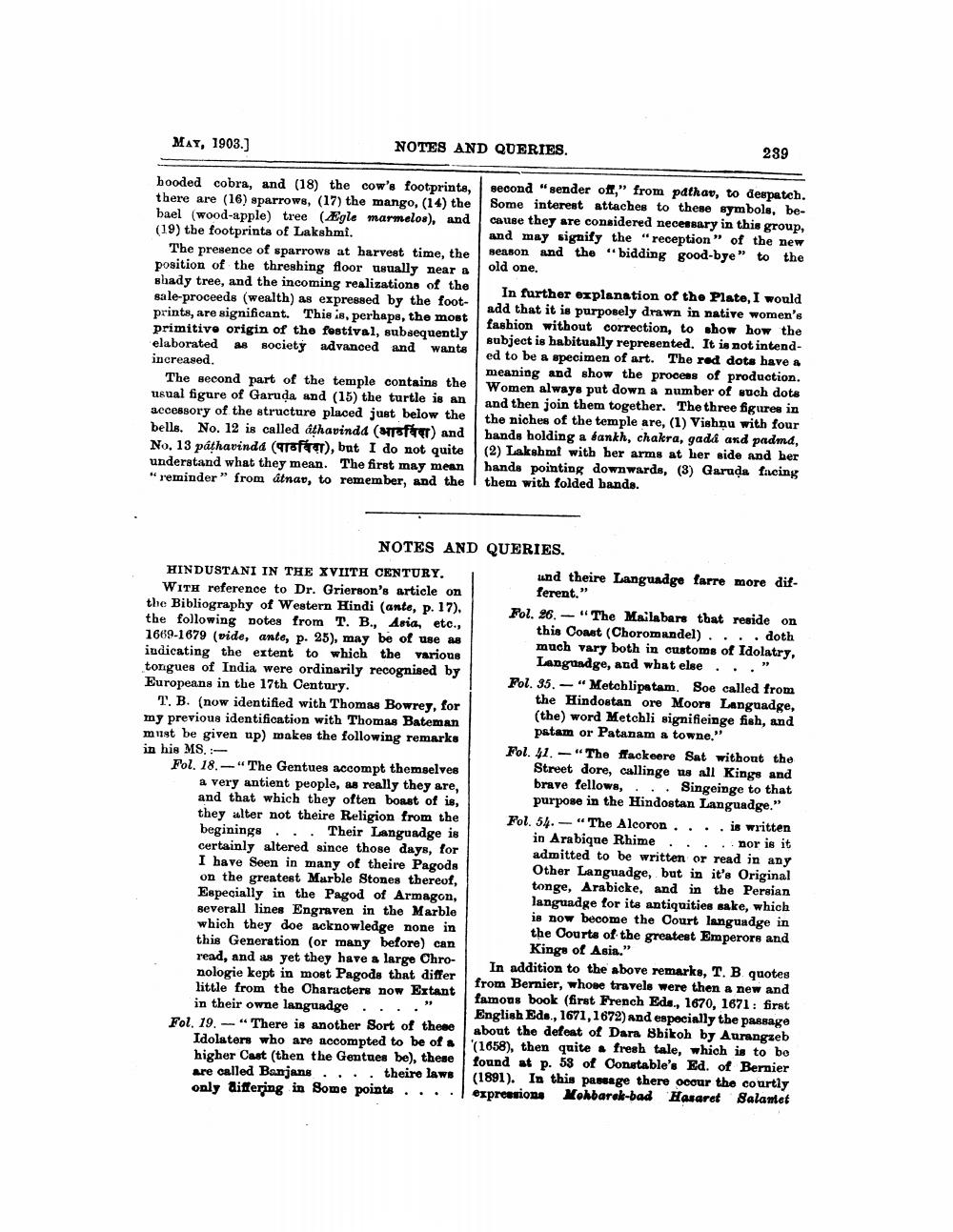________________
MAY, 1903.)
NOTES AND QUERIES.
239
booded cobra, and (18) the cow's footprinte, second "sender oft," from pathav, to despatch. there are (16) sparrows, (17) the mango, (14) the Some interest attaches to these symbols, bebael (wood-apple) tree (Egle marmelos), and cause they are considered necessary in this group, (19) the footprints of Lakshmi.
and may signify the "reception of the new The presence of sparrows at harvest time, the
season and the "bidding good-bye" to the position of the threshing floor usually near a old one. shady tree, and the incoming realizations of the
In further explanation of the Plate, I would sale-proceeds (wealth) as expressed by the foot
add that it is purposely drawn in native women's prints, are significant. This is perhaps, the most
fashion without correction, to show how the primitive origin of the festival, subsequently
subject is habitually represented. It is not intendelaborated society advanced and wants
ed to be a specimen of art. The red dots have a increased.
meaning and show the process of production. The second part of the temple contains the
Women always put down a number of such dots usual figure of Garuda and (15) the turtle is an
and then join them together. The three figures in accessory of the structure placed just below the the niches of the temple are, (1) Vishnu with four bells. No. 12 is called athavindt ( fr) and hands holding a bankh, chakra, gada and padmd, No. 13 pathavinda (arof), but I do not quite (2) Lakshmi with her arms at her side and her understand what they mean. The first may mean hands pointing downwards, (3) Garuda facing
reminder" from átnar, to remember, and the I them with folded bands.
NOTES AND QUERIES. HINDUSTANI IN THE XVIITH CENTURY.
und theire Languadge farre more difWITH reference to Dr. Grierson's article on
ferent." the Bibliography of Western Hindi (ante, p. 17).
Fol. 26. - "The Mailabars that reside on the following notes from T. B., Asia, etc.,
this Coast (Choromandel) .... doth 1669-1679 (vide, ante, p. 25), may be of use as
much vary both in customs of Idolatry, indicating the extent to which the various
Language, and what else ..." tongues of India were ordinarily recognised by Europeans in the 17th Century.
Fol. 35. — “Metchlipatam, Soe called from T. B. (now identified with Thomas Bowrey, for
the Hindostan ore Moors Languadge,
(the) word Metchli signifieinge fish, and my previous identification with Thomas Bateman
patam or Patanam a towne." must be given up) makes the following remarks in his MS. :
Fol. 41. -"The fackeere Sat without the Fol. 18. -"The Gentues accompt themselves
Street dore, callinge us all Kings and a very antient people, as really they are,
brave fellows,... Singeinge to that and that which they often boast of is,
purpose in the Hindostan Languadge." they ulter not theire Religion from the Fol. 54. - "The Alcoron.... is written beginings ... Their Languadge is
in Arabiqne Rhime.... nor is it certainly altered since those days, for
admitted to be written or read in any I have seen in many of theire Pagode
Other Languadge, but in it's Original on the greatest Marble Stones thereof,
tonge, Arabicke, and in the Persian Especially in the Pagod of Armagon,
languadge for its antiquities sake, which Beverall lines Engraven in the Marble
is now become the Court languadge in which they doe acknowledge none in
the Courts of the greatest Emperors and this Generation (or many before) can
Kings of Asia." read, and as yet they have a large Chro
In addition to the above remarks, T. B quotes nologie kept in most Pagods that differ
from Bernier, whose travels were then a new and little from the Characters now Extant
famous book (first French Eds., 1670, 1671: first in their owne languadge ...."
English Eds., 1671, 1672) and especially the passage Fol. 19.-" There is another Sort of these about the defeat of Dara Bbikoh by Aurangzeb
Idolaters who are accompted to be of a '(1658), then quite a fresh tale, which is to bo higher Cast (then the Gentues be), these found at p. 58 of Constable's Ed. of Bernier are called Banjans .... theire laws (1891). In this passage there ocour the courtly only differing in some points ... expressions Xehbarek-bad Hasaret Salamet




